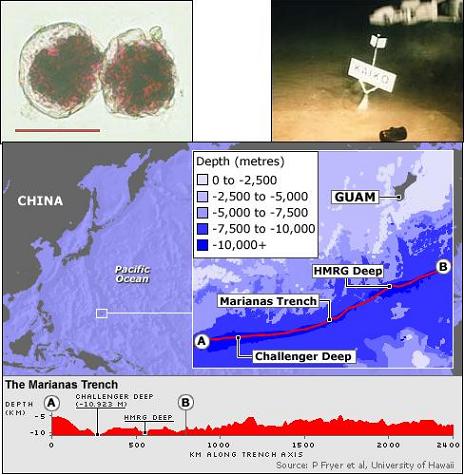The members of the research team said that these organisms are very similar to plankton, single-celled creatures found mainly near the surface of the sea. According to their estimation, it took the creatures that were discovered between 6 and 9 million years to adapt to the enormous pressure at this depth, about 1,100 atmospheres
12.2.2005
By: Avi Blizovsky
Direct link to this page: https://www.hayadan.org.il/lifetrench110205.html

Scientists from Japan discovered single-celled creatures at a depth of 11 km at the bottom of the Pacific Ocean. The creatures were discovered in samples taken by a research submarine of the Japanese Institute of Marine Research. The members of the research team said that these organisms are very similar to plankton, single-celled creatures found mainly near the surface of the sea. According to their estimation, it took the discovered creatures between 6 and 9 million years to adapt to the enormous pressure at this depth, about 1,100 atmospheres.
Life thrives in compressed depths
Tiny single-celled species, many of which were previously unknown, have been found at the deepest point in the oceans on Earth, at a depth of approximately 11 kilometers. Soft-walled porcupines, a type of plankton, were brought up by Japanese scientists using the unmanned submarine Kiako.
Yoko Todo and his colleagues reported the discovery in the journal Science. They said the creatures had adapted to the crushing pressures present in the Mariana Islands Trench, also known as the Challenger Deeps.
The hole in the ocean floor is completely dark and huge columns of water are pushed down with a force a thousand times greater than on the surface, almost 110 thousand kilopascals (1,100 atmospheres).
Foraminifera are considered the most abundant life form after bacteria. They often have shells, but these creatures are soft because there is not enough calcium carbonate at such depths to build hard parts. Kiako drinks the pore water from the first centimeter of sediment in the depths of Challenger, 10,896 meters below sea level.
The Mariana Trench was formed as part of a gap created when the land in the western Pacific Ocean was pushed under the Philippine tectonic plate.
The team said that the deep abyss of the western Pacific Ocean was formed 6-9 million years ago. In their article in the journal Science, they write: "The hyosin lineage to which the new porcupines belong includes the only species that penetrates fresh water on land, and the analysis of the DNA of the new creature raises the possibility that they represent a primitive form of creatures that have existed since the Precambrian period in which they also evolved Complex creatures with multiple chambers.”
Similar groups, although not identical, were also found in other abysses, although slightly less deep than this abyss.
Kiako was lost at sea in 2003The gills fed on particles of organic matter that fell on them from the shallower water or substances absorbed in the seawater. The Challenger Abyss was discovered in 1951 by the British Navy ship Challenger 2, hence its name. Kiako herself was lost on a mission in the Nankai Canal in 2003. There is currently no remotely controlled vessel in service that can reach the bottom of the Mariana Trench. The scientific team includes members from Shizuoka University, the Marine Science and Technology Agency, Nagasaki University and the Oceanographic Center in Southampton, UK.
